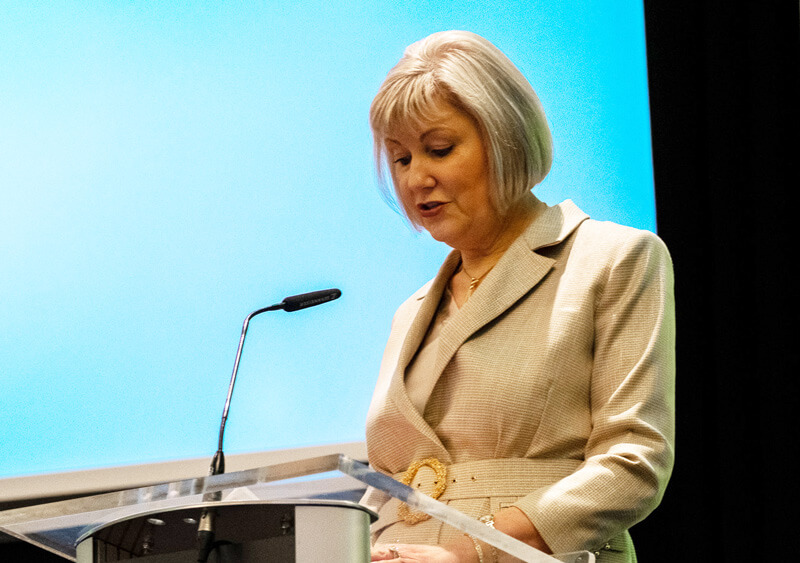
The Irish acute public hospital services would require between 12,418 and 15,491 additional staff over the next 13 years, according to a research undertaken by the ESRI in relation to a workforce projection, carried out for the HSE and published in July of this year, Anne Marie Hoey, HSE National Director, Human Resources, told the Conference. These posts were in addition to replacement posts of circa 9,500 per annum.
The figures were arrived by applying the ESRI’s Hippocrates healthcare projection model.
The positive news was that around 6,000 of the additional staff in the categories of medical; nursing and midwifery; certain HSCP grades; HCA HSCP assistant grades, had been recruited in acute centres since the beginning of 2020. Since 2020, the HSE had grown its entire workforce by 15,428 or 12.9 % (in addition to replacement posts of circa 9,500 per annum).
She said that as the HSE prepared for the implementation of Sláintecare and RHAs, this report, focussing on Acute Hospitals, raised important considerations in terms of acute workforce investment, workforce planning and training over the coming years. Importantly, the second phase of the work which would focus on requirements in Community Services would further strengthen our planning and implementation of Sláintecare.
Ms. Hoey said the main findings of this report were that workforce requirements for all public acute staff categories examined and across all current Hospital Groups and Regional Health Area configurations were set to increase substantially over the coming years. Projected workforce requirements were primarily driven by the underlying projected demand for hospital care, itself a function of a projected growing and ageing population.
Nationally, the population was projected to be 5.8 million by 2035, under our Central population growth scenario, an increase of close to 500,000 between 2019 and 2035. The number aged 85 years and older was projected to more than double.
Driven by projected demographic change, particularly population ageing, workforce requirements for all staff categories examined were projected to increase substantially by 2035. The largest increases in workforce were projected for health and social care professionals who were particularly required by older people in hospital.
The largest projected increases in workforce requirements were recorded for regions located in the east of the country.
Speaking on “Changed World of Healthcare Staff,” she said the HSE was the largest employer in the State. Between December 2019 and September of 2022, an additional 15,428 WTEs were recruited, an increase of 12.9 per cent, which brought the total to 154.566.
The largest increase was in Nursing and Midwifery, which had an additional 4,452 WTE, an 11.7 per cent increase bringing the total to 42,657. The largest percentage increase, 20.1 per cent was in Management and Administration, bringing the total to 22,635. Medical and Dental increased by 1,614 (14.9 per cent), bringing the total to 12472 and HSCP increased by 14.2 per cent to 19174.
Overall, Acute Services increased by 9,904 WTE and Community Services increased 4,703 WTE.
Turning to waiting list management, Ms. Hoey said that shortages in acute care capacity had contributed to larger and longer waiting lists for public hospital treatment. This was exacerbated by COVID-19.
Hippocrates was developed to assess demand implications of addressing these waiting list issues. There were two dimensions to this – how much once-off additional activity was required to reduce the current backlogs and how much recurring additional activity was required to maintain lower waiting times.
Then there was the question of avoidable hospitalisations and the impact of improved access to and investment in community care on acute demand and workforce requirements. However greater access to community services did not necessarily result in reduced use of hospital services. Changes in the ratio of consultants to NCHDs and the ratio of trainees and non trainees to consultants would also mean increases in consultant numbers.
The numbers in training for health care professionals had increased, but not at the rate required. The HSE was targeting recruitment of health care professional graduates and investing in development of its workforce specialist skills. However, current actions would not be sufficient for future requirements. The HSE was also competing in a global workforce market for health care professionals.
“The health service is facing sustained and significant demand for qualified health and social care professionals within its services. This demand will remain and become more significant due to a number of factors, social and environmental, health service developments, talent supply and in response to feedback and insights from our colleagues and our services. The HSE Recruitment, Reform and Resourcing Programmewas established this year to take a holistic view of the resource demand and supply, and use relevant data, research and insights to create a Strategic Resourcing Plan per profession, with short, medium and long term actions. It 1s aimed at focussing on the present and the future.
Anne Marie Hoey is the National Director of Human Resources for the HSE since 2019. She has over 30 years’ experience in the Irish health service, holding a number of senior management roles, across acute hospitals, community services and Head of PCRS. Her focus includes strategic and operational management, change management and people management. She holds a BSc in management in addition to a Master’s Degree in Health Service Management from Trinity College and is a Chartered Fellow of CIPD. Her focus includes strategic and operational management, change management and people management.

